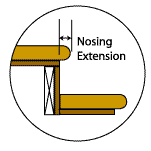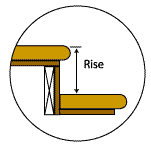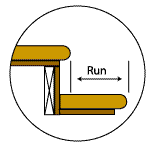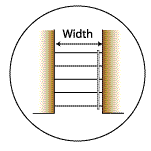Stairs Residential Building Code for the United States
The Stairs- Residential Building Code for the U.S. is a municipal regulation. Thus it varies by state and town.
Some jurisdictions base their legislation on the 2000 and 2003 International Residential Code (IRC). Other communities seem to be still using the 1997 Uniform Building Code (UBC). In all cases, each jurisdiction has amended the code to reflect local concerns.. ie. flooding or earthquake prone areas.
It is absolutely essential that you check with your local office as the following information is only offered to suggest guidelines as to what issues and answers you might expect related to the stairs-residential building code... good luck! happy woodworking..
| Nosing Extension: |
Code Requirements
|
Maximum overhang for nosing is somewhere between 1 ¼" & 1 ½". Some states legislate a minimum of ¾", including floor and landings. |
 |
| Risers & Runs: | |
|
Riser Height: Maximum of between 7 ¾" & 8 ¼" (some states regulate a minimum of 6") |

|
|
Run: Minimum between 9-10" (not counting the part underneath the "nosing" of the tread above). With a note that runs of over 10 1/2" will usually require three balusters per tread to comply with the 4" maximum opening between spindles. |
 |
| Variation in Rise & Run: | Can only have a 3/8 inch difference between the largest and the smallest rise and the largest and smallest run. |
| Winder and Spiral Stairs: | |
| Winder Stairs: | Stairways that turn a corner. These treads are narrow on one end and wider at the other. |
| Spiral/Circular Stairs: | Have their own regulations that often stipulate the minimum width of around 6" at the smallest end of pie shaped treads, and often specify that a tread must be somewhere between 9-10" wide, measured 12 inches from the narrowest end. |
| Stairways Width: | |
|
Stair Width: Minimum 36" with a stipulation allowing a wall mounted handrail to project from each side 3 ½" |

|
| General Comments: | |
Where you know your home is going to require a final inspection from the Building Controls Department, a wise step, would be to get all your products and installation methods preapproved by this department. It costs less if you only have to do it once! Any railing installations that are not standard (ie. as per code), must have an engineer's stamp of approval for the local building controls office to pass. For those of you that are "only" rennovating, you still need a building permit. If you decide to bypass this obligation, remember the door you are leaving open, if someone has an accident, involving a railing that is NOT constructed to todays code. You will be liable! We ALWAYS recommend that you build to current code. MAKE it STRONG! MAKE it SAFE! check FIRST!
|
|
to purchase Hardwood Stairs link to our sister site
